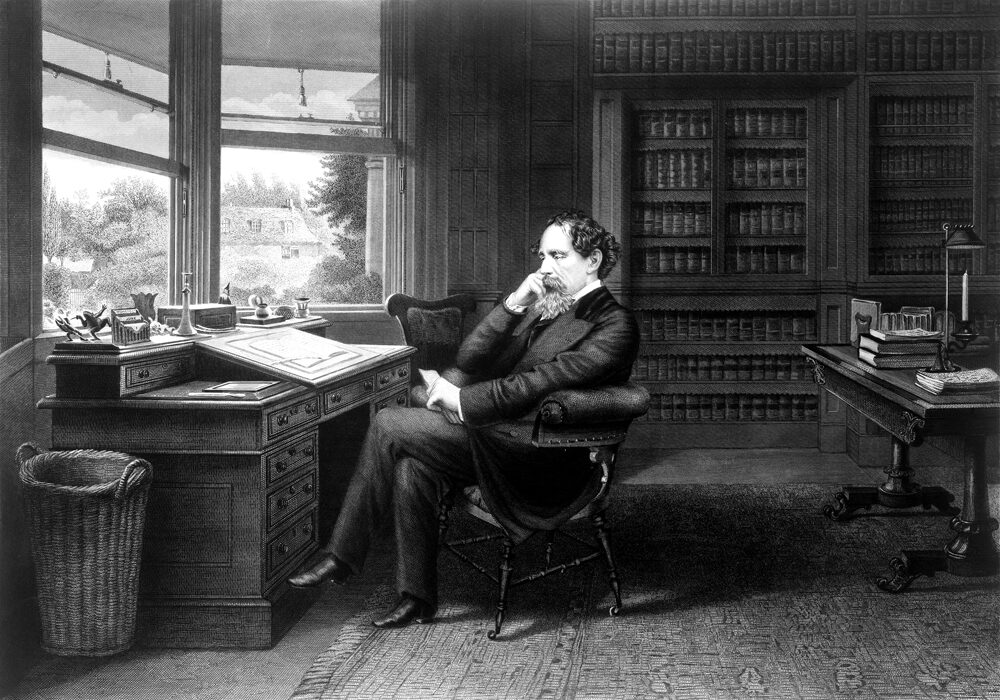
A drawing of 19th century English author Charles Dickens in his study. Dickens’s poor childhood would later influence his writings.
“Marley was dead: to begin with. There is no doubt whatever about that.”
It’s a rather dark way for a Christmas story to begin, yet that’s exactly how author Charles Dickens opens “A Christmas Carol.” And he’s quite clear on what this book is about. The full title is “A Christmas Carol: Being a Ghost Story of Christmas.”
Dickens and his characters Ebenezer Scrooge, Bob Cratchit, and Tiny Tim will be forever connected with the Christmas season. “A Christmas Carol,” which hit the streets of London on Dec. 19, 1843, shaped the festive way we’ve come to celebrate the holiday.
Some call the author “the man who saved Christmas.” Regardless of how you feel about that, you can’t argue with his influence on the holiday.
In 17th century England, way before the publication of “A Christmas Carol,” many viewed Christmas as a day for piety and reflection rather than celebration and festivity. This was possibly in response to the extravagance associated with some church denominations’ practices.
Some attribute the tamping down on festivities to Oliver Cromwell, the Lord Protector of the Commonwealth of England, Scotland, and Ireland from 1653 until his death in 1658. He is sometimes attributed with banning Christmas decorations and other festive traditions, though parliament at the time had a role in how holidays were celebrated.
Whatever the reason or cause, the English and, eventually, the American colonies did not celebrate Christmas as we do today. In fact, in the years leading up to the publication of “A Christmas Carol” — and probably for some time after — mills and factories forced their employees, many of whom were children, to work on Christmas day, just like any other day.
Dickens knew all too well the struggles of the impoverished in the early 19th century. He was born in 1812. Only 12 years later, he was working long hours in unimaginable conditions by today’s standards at the Warren’s Shoe Blacking factory after his father was sent to debtors prison.
Those hard days stuck with Dickens and influenced his writing.
Though he tried to put his past behind him, Dickens couldn’t let it go. He remained sensitive to the plight of the poor.
In 1843, during a trip to Scotland, Dickens encountered a tombstone inscribed with “Ebenezer Lennox Scroggie — a meal man.” “Meal man” referred to Scroggie’s occupation, meaning he probably sold corn. But, by some accounts, Dickens misread the inscription as “mean man.”
As an author, Dickens held onto interesting tidbits, never knowing when they might come in handy.
Sometime that same year, Dickens began formulating his next piece. This one would not be a grand, expansive work such as “Oliver Twist” or “Nicholas Nickleby” or his later novels “David Copperfield” and “A Tale of Two Cities.” Still, it’s purpose was the same: to examine human nature and our relationship to redemption.
He began writing “A Christmas Carol” in October 1843 and finished it in about six weeks. The novella hit the streets on Dec. 19, 1843, and, by Christmas Eve, all 6,000 copies had sold out. While it was not a financial success, it became — and remains — one of his most popular works.
It also ushered in the Christmas spirit. After its publication, people in both England and the United States began celebrating the holiday in a new way. They saw it as a chance to spread good cheer and tidings. Some of this can be attributed to Scrooge’s journey that Christmas Eve and the three ghosts, or spirits, who visited him.
People saw in Scrooge a world that had become cold, dark, and inhumane to the poor and others. But they also saw the possibility of redemption, which Scrooge had found.
Dickens painted a picture of hope for ourselves and society. And many took up the call by helping others.
Was the story the only catalyst for a festive Christmas revival? Probably not. During this time, German traditions such as carols and Christmas trees found their way into English and American homes, partly thanks to Prince Albert’s marriage to Queen Victoria in 1840.
But we can’t overlook the impact of “A Christmas Carol.” Today, it’s one of the most reprised works on stage and screen and is read by thousands each year. Dickens wrote it to be read aloud, which might be a nice tradition to start with family and friends. In fact, the author held public readings of “A Christmas Carol” each holiday season from 1853-69. (He died in June 1870 at the age of 58.)
While he might not have saved Christmas, Dickens inspired how we celebrate the holiday today.
As Dickens describes Scrooge’s transformation, there’s a lesson in there for all of us: “He became a good friend, as good a master, and as good a man, as the good city knew, or any other good old city, town, or borough, in the good old world.”









